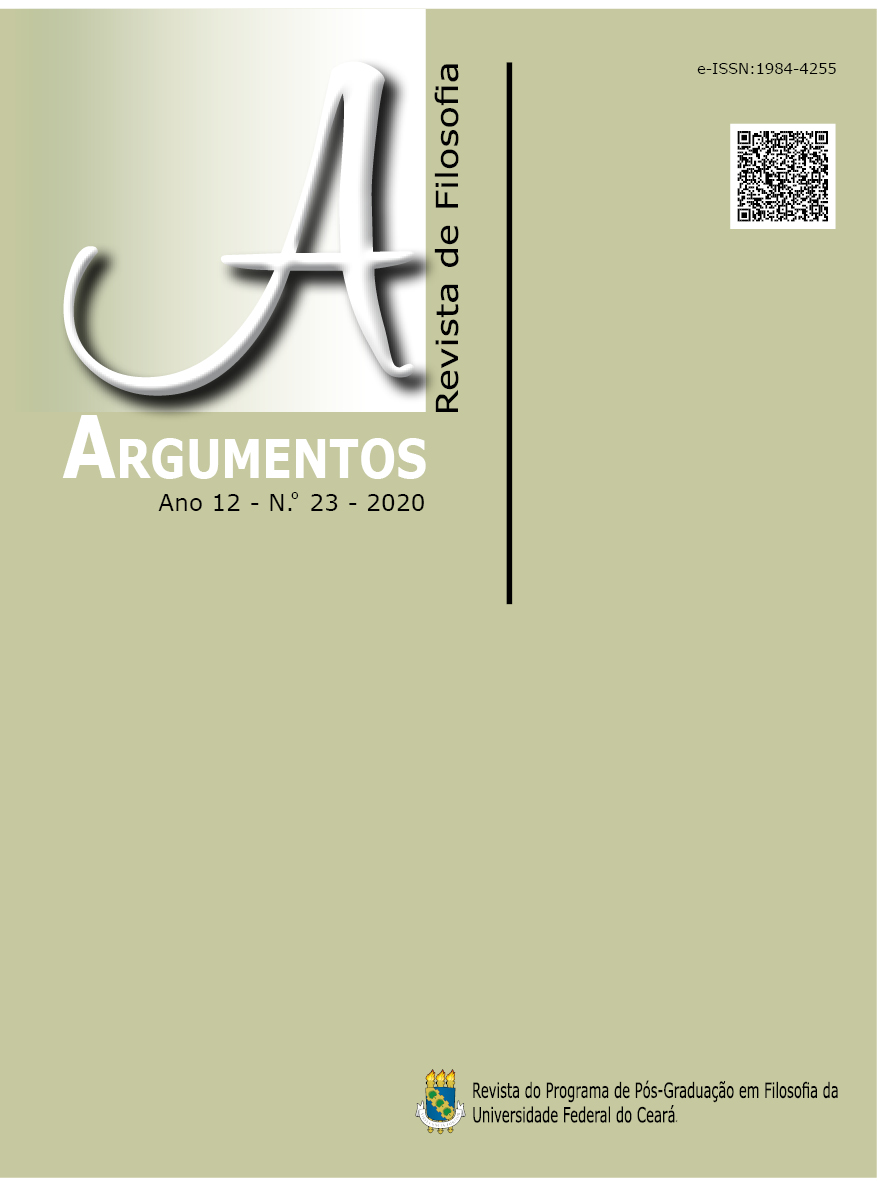Semantic ambiguity does not imply syntactic ambiguity
DOI:
https://doi.org/10.36517/Argumentos.23.1Palavras-chave:
Ambiguidade. Forma lógica. Modelo. Semântica. Sintaxe.Resumo
Um problema para resolver na gramática generativa é explicar por que os meninos são capazes de notar quando uma frase ou expressão é ambígua, mesmo que não tenham recebido ensino explícito para isso. A teoria dos modelos mentais pode dar uma explicação nesse sentido. Essa explicação é baseada na ideia de que as pessoas interpretam as mensagens linguísticas considerando os modelos semânticos correspondentes a elas, e foi proposto que as estruturas sintáticas dessas mensagens podem ser recuperadas tomando esses mesmos modelos em consideração. No entanto, o ponto deste trabalho é que tenta mostrar que a ambiguidade ao nível semântico, isso é, os casos nos que modelos se referindo a fatos diferentes podem ser atribuídos a uma frase, não necessariamente leva a uma ambiguidade ao nível sintático. Como é argumentado, é possível captar modelos descrevendo várias circunstâncias opostas por meio de uma só forma lógica.Downloads
Referências
HINTERECKER, T., KNAUFF, M., & JOHNSON-LAIRD, P. N. Modality, probability, and mental models. Journal of Experimental Psychology: Learning, Memory, and Cognition, v. 42, n. 10, 2016. p. 1606-1620.
HORNSTEIN, N. Logic as Grammar: An Approach to Meaning in Natural Language. Cambridge, MA: The Massachusetts Institute of Technology (MIT) Press, 1987.
HORNSTEIN, N. Logical Form: From GB to Minimalism. Cambridge, MA, & Oxford, UK: Blackwel, 1995.
JOHNSON-LAIRD, P. N. (2010). Against logical form. Psychologica Belgica, v. 50, n. 3/4, 2010. p. 193-221.
JOHNSON-LAIRD, P. N. Inference with mental models. In: Holyoak, K. J. & R. G. Morrison, R. G. (Eds.). The Oxford Handbook of Thinking and Reasoning. New York, NY: Oxford University Press, 2012.
JOHNSON-LAIRD, P. N. How to improve thinking. In: Wegerif, R., Li, L., & Kaufman, J. C. (Eds.). The Routledge International Handbook of Research on Teaching Thinking. Abingdon, UK, & New York, NY: Routledge, 2015.
JOHNSON-LAIRD, P. N., KHEMLANI, S., & GOODWIN, G. P. Logic, probability, and human reasoning. Trends in Cognitive Sciences, v. 19, n. 4, 2015. p. 201-214.
KHEMLANI, S., BYRNE, R. M. J., & JOHNSON-LAIRD, P. N. Facts and possibilities: A model-based theory of sentential reasoning. Cognitive Science, v. 42, n. 6, 2018. p. 1887-1924.
KHEMLANI, S. & JOHNSON-LAIRD, P. N. Why machines don’t (yet) reason like people. Künstliche Intelligenz, 2019. Retrieved from: https://link.springer.com/article/10.1007%2Fs13218-019-00599-w#aboutcontent
LÓPEZ-ASTORGA, M. Language acquisition and innate cognitive abilities: An approach from the mental models theory. Círculo de Lingüística Aplicada a la Comunicación (CLAC), n. 77, 2019a. p. 233-242.
LÓPEZ-ASTORGA, M. Possible roles for semantics and syntax in a government-binding structure. Prometeica, n. 19, 2019b. p. 72-79.
ORENES, I. & JOHNSON-LAIRD, P. N. Logic, models, and paradoxical inferences. Mind & Language, v. 27, n. 4, 2012. p. 357-377.
QUELHAS, A. C., RASGA, C., & JOHNSON-LAIRD, P. N. A priori true and false conditionals. Cognitive Science, v. 41, n. 55, 2017. p. 1003-1030.
QUELHAS, A. C., RASGA, C., & JOHNSON-LAIRD, P. N. The analytic truth and falsity of disjunctions. Cognitive Science, v. 43, n. 9, 2019. Retrieved from: https://modeltheory.org/papers/2019analytic-truth-disjns.pdf
Downloads
Publicado
Versões
- 2025-03-28 (2)
- 2020-04-19 (1)
Como Citar
Edição
Seção
Licença
Copyright (c) 2020 Argumentos - Revista de Filosofia

Este trabalho está licenciado sob uma licença Creative Commons Attribution 4.0 International License.
Autores que publicam nesta revista concordam com os seguintes termos (SOBRE COPYRIGHT E POLÍTICA DE ACESSO LIVRE):
1. Autores mantém OS DIREITOS AUTORAIS concedidos à revista OU Direito de Primeira Publicação, com o trabalho simultaneamente licenciado à Atribuição de Licença Creative Commons (CC BY) que permite o compartilhamento dos trabalhos com reconhecimento de autoria e publicação inicial nesta revista.
2. Autores têm permissão para aceitar contratos, distribuição não-exclusiva da versão do trabalho publicada nesta revista (por exemplo: publicar no repositório institucional ou como um capítulo do livro), com reconhecimento de autoria e publicação inicial nesta revista.
3. Autores têm permissão e são estimulados a publicar e distribuir seu trabalho on-line (por exemplo: em repositórios institucionais ou em sua página pessoal) mesmo durante o processo editorial, haja visto que isso pode aumentar o impacto e citação do trabalho publicado.




.jpg)










._._3.png)
1.jpg)
._._._.png)
